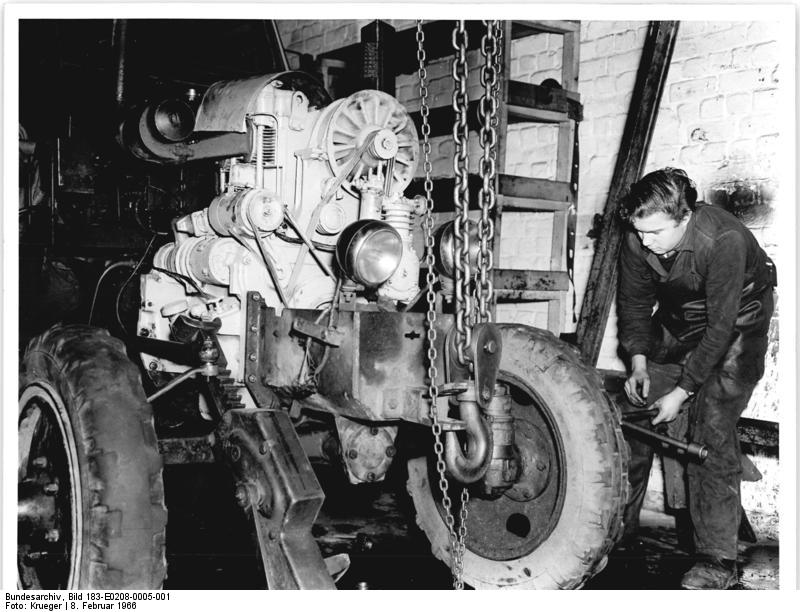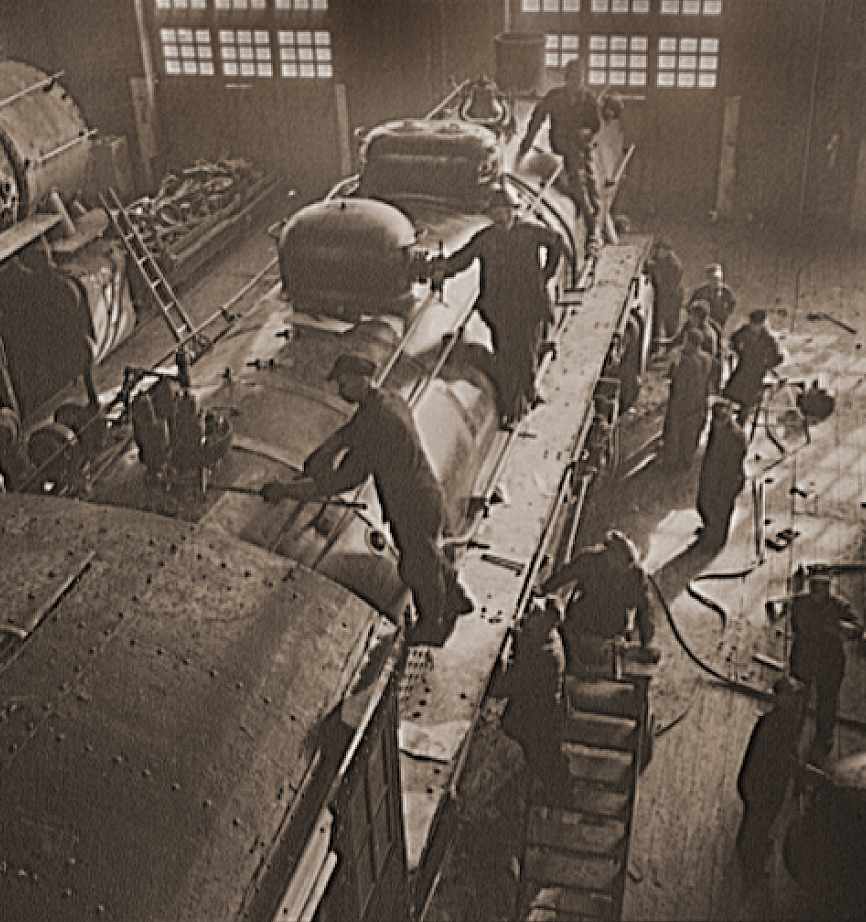|
Workshop
Beginning with the Industrial Revolution era, a workshop may be a room, rooms or building which provides both the area and tools (or machinery) that may be required for the manufacture or repair of manufactured goods. Workshops were the only places of production until the advent of industrialization and the development of larger factories. In the 20th and 21st century, many Western homes contained a workshop in either the garage, basement, or an external shed. Home workshops typically contain a workbench, hand tools, power tools, and other hardware. Along with the practical application of repairing goods, workshops are often used to tinker and make prototypes. Some workshops focus exclusively on automotive repair or restoration although there are a variety of workshops in existence today. Woodworking, metalworking, electronics, and other types of electronic prototyping workshops are among the most common. Backshop In some repair industries, such as locomotives and ... [...More Info...] [...Related Items...] OR: [Wikipedia] [Google] [Baidu] |
Prototypes
A prototype is an early sample, model, or release of a product built to test a concept or process. It is a term used in a variety of contexts, including semantics, design, electronics, and software programming. A prototype is generally used to evaluate a new design to enhance precision by system analysts and users. Prototyping serves to provide specifications for a real, working system rather than a theoretical one. In some design workflow models, creating a prototype (a process sometimes called materialization) is the step between the formalization and the evaluation of an idea. A prototype can also mean a typical example of something such as in the use of the derivation 'prototypical'. This is a useful term in identifying objects, behaviours and concepts which are considered the accepted norm and is analogous with terms such as stereotypes and archetypes. The word ''prototype'' derives from the Greek , "primitive form", neutral of , "original, primitive", from πρῶτο ... [...More Info...] [...Related Items...] OR: [Wikipedia] [Google] [Baidu] |
The New Yankee Workshop
''The New Yankee Workshop'' is an American half-hour woodworking television series produced by WGBH-TV, WGBH Boston, which aired on PBS. Created in 1989 by Russell Morash, the program was hosted by Norm Abram, a regular fixture on Morash's television series ''This Old House''. Overview ''The New Yankee Workshop'' featured the construction of woodworking projects, including workshop accessories, architectural details and furniture projects ranging from simple pieces to complex, high-quality reproductions of antique classic furniture. In the course of 21 seasons, approximately 235 projects were produced. In addition to furniture and cabinets, the show also focused on outdoor projects such as the building of a gazebo, shed, greenhouse, sailing boat, flag pole, mail box, cupola, and fences. He also goes to different places that are related to woodworking. Theme song ''The New Yankee Workshop'' theme song consists of a fast-paced guitar tune with a harmonica sound. Set design The sho ... [...More Info...] [...Related Items...] OR: [Wikipedia] [Google] [Baidu] |
Studio
A studio is an artist or worker's workroom. This can be for the purpose of acting, architecture, painting, pottery (ceramics), sculpture, origami, woodworking, scrapbooking, photography, graphic design, filmmaking, animation, industrial design, radio or television production broadcasting or the making of music. The term is also used for the workroom of dancers, often specified to dance studio. The word ''studio'' is derived from the , from , from ''studere'', meaning to study or zeal. The French term for studio, ''atelier'', in addition to designating an artist's studio is used to characterize the studio of a fashion designer. ''Studio'' is also a metonym for the group of people who work within a particular studio. :uz:Studiya Art studio The studio of any artist, especially from the 15th to the 19th centuries, characterized all the assistants, thus the designation of paintings as "from the workshop of..." or "studio of..." An art studio is sometimes called an atelier, ... [...More Info...] [...Related Items...] OR: [Wikipedia] [Google] [Baidu] |
Skylab
Skylab was the first United States space station, launched by NASA, occupied for about 24 weeks between May 1973 and February 1974. It was operated by three separate three-astronaut crews: Skylab 2, Skylab 3, and Skylab 4. Major operations included an orbital workshop, a solar observatory, Earth observation, and hundreds of experiments. Unable to be re-boosted by the Space Shuttle, which was not ready until 1981, Skylab's orbit eventually decayed, and it disintegrated in the atmosphere on July 11, 1979, scattering debris across the Indian Ocean and Western Australia. Overview Skylab was the only space station operated exclusively by the United States. A permanent station was planned starting in 1988, but funding for this was canceled and replaced with United States participation in an International Space Station in 1993. Skylab had a mass of with a Apollo command and service module (CSM) attached and included a workshop, a solar observatory, and several hundred life sc ... [...More Info...] [...Related Items...] OR: [Wikipedia] [Google] [Baidu] |
Machine Shop
A machine shop or engineering workshop (UK) is a room, building, or company where machining, a form of subtractive manufacturing, is done. In a machine shop, machinists use machine tools and cutting tools to make parts, usually of metal or plastic (but sometimes of other materials such as glass or wood). A machine shop can be a small business (such as a job shop) or a portion of a factory, whether a toolroom or a production area for manufacturing. The building construction and the layout of the place and equipment vary, and are specific to the shop; for instance, the flooring in one shop may be concrete, or even compacted dirt, and another shop may have asphalt floors. A shop may be air-conditioned or not; but in other shops it may be necessary to maintain a controlled climate. Each shop has its own tools and machinery which differ from other shops in quantity, capability and focus of expertise. The parts produced can be the end product of the factory, to be sold to customers in ... [...More Info...] [...Related Items...] OR: [Wikipedia] [Google] [Baidu] |
Laboratory
A laboratory (; ; colloquially lab) is a facility that provides controlled conditions in which scientific or technological research, experiments, and measurement may be performed. Laboratory services are provided in a variety of settings: physicians' offices, clinics, hospitals, and regional and national referral centers. Overview The organisation and contents of laboratories are determined by the differing requirements of the specialists working within. A physics laboratory might contain a particle accelerator or vacuum chamber, while a metallurgy laboratory could have apparatus for casting or refining metals or for testing their strength. A chemist or biologist might use a wet laboratory, while a psychologist's laboratory might be a room with one-way mirrors and hidden cameras in which to observe behavior. In some laboratories, such as those commonly used by computer scientists, computers (sometimes supercomputers) are used for either simulations or the analysis of data. Scient ... [...More Info...] [...Related Items...] OR: [Wikipedia] [Google] [Baidu] |
Hackspace
A hackerspace (also referred to as a hacklab, hackspace, or makerspace) is a community-operated, often "not for profit" (501(c)(3) in the United States), workspace where people with common interests, such as computers, machining, technology, science, digital art, or electronic art, can meet, socialize, and collaborate. Hackerspaces are comparable to other community-operated spaces with similar aims and mechanisms such as Fab Lab, men's sheds, and commercial "for-profit" companies. History Hackerspaces with open membership became common throughout Germany in the 1990s in the orbit of the German Chaos Computer Club (CCC), with the c-base being probably an example. The concept, however, was limited to less than a dozen spaces within Germany, and did not spread beyond borders at first. Most likely this was because initial founding costs were prohibitive for small groups without the support of a large organization like the CCC. From 1997, Chicago's Autonomous Zone Infoshop hosted " ... [...More Info...] [...Related Items...] OR: [Wikipedia] [Google] [Baidu] |
Repairs
The technical meaning of maintenance involves functional checks, servicing, repairing or replacing of necessary devices, equipment, machinery, building infrastructure, and supporting utilities in industrial, business, and residential installations. Over time, this has come to include multiple wordings that describe various cost-effective practices to keep equipment operational; these activities occur either before or after a failure. Definitions Maintenance functions can defined as maintenance, repair and overhaul (MRO), and MRO is also used for maintenance, repair and operations. Over time, the terminology of maintenance and MRO has begun to become standardized. The United States Department of Defense uses the following definitions:Federal Standard 1037C and from MIL-STD-188 and from the Department of Defense Dictionary of Military and Associated Terms * Any activity—such as tests, measurements, replacements, adjustments, and repairs—intended to retain or restore a func ... [...More Info...] [...Related Items...] OR: [Wikipedia] [Google] [Baidu] |
Railway Workshop
Railway workshops are railway facilities in which rolling stock is repaired. While often colocated with engine sheds to perform routine tasks as well as major repairs, in some countries separated concepts exist with ''railway workshops'' being specialized in major repairs and general inspections. In German-speaking countries, the generic names ''Werkstatt'', or specifically in Austria ''Hauptwerkstatt'', are commonly used, except for Germany, where railway workshops maintained by Deutsche Bahn are called Ausbesserungswerk or simply ''Werk''. List of railway workshops *Australia **Eveleigh Railway Workshops **Midland Railway Workshops **Newport Workshops *India **Jamalpur Locomotive Workshop *New Zealand **Addington Workshops **East Town Workshops **Hillside Engineering **Hutt Workshops **Newmarket Workshops **Otahuhu Workshops **Petone Workshops *Germany **see Ausbesserungswerk See also *Conservation and restoration of rail vehicles *Motive power depot The motive p ... [...More Info...] [...Related Items...] OR: [Wikipedia] [Google] [Baidu] |
Aircraft
An aircraft is a vehicle that is able to fly by gaining support from the air. It counters the force of gravity by using either static lift or by using the dynamic lift of an airfoil, or in a few cases the downward thrust from jet engines. Common examples of aircraft include airplanes, helicopters, airships (including blimps), gliders, paramotors, and hot air balloons. The human activity that surrounds aircraft is called ''aviation''. The science of aviation, including designing and building aircraft, is called '' aeronautics.'' Crewed aircraft are flown by an onboard pilot, but unmanned aerial vehicles may be remotely controlled or self-controlled by onboard computers. Aircraft may be classified by different criteria, such as lift type, aircraft propulsion, usage and others. History Flying model craft and stories of manned flight go back many centuries; however, the first manned ascent — and safe descent — in modern times took place by larger hot-air ... [...More Info...] [...Related Items...] OR: [Wikipedia] [Google] [Baidu] |
Locomotives
A locomotive or engine is a rail transport vehicle that provides the motive power for a train. If a locomotive is capable of carrying a payload, it is usually rather referred to as a multiple unit, motor coach, railcar or power car; the use of these self-propelled vehicles is increasingly common for passenger trains, but rare for freight (see CargoSprinter). Traditionally, locomotives pulled trains from the front. However, push-pull operation has become common, where the train may have a locomotive (or locomotives) at the front, at the rear, or at each end. Most recently railroads have begun adopting DPU or distributed power. The front may have one or two locomotives followed by a mid-train locomotive that is controlled remotely from the lead unit. __TOC__ Etymology The word ''locomotive'' originates from the Latin 'from a place', ablative of 'place', and the Medieval Latin 'causing motion', and is a shortened form of the term ''locomotive engine'', which was first ... [...More Info...] [...Related Items...] OR: [Wikipedia] [Google] [Baidu] |



.jpg)





